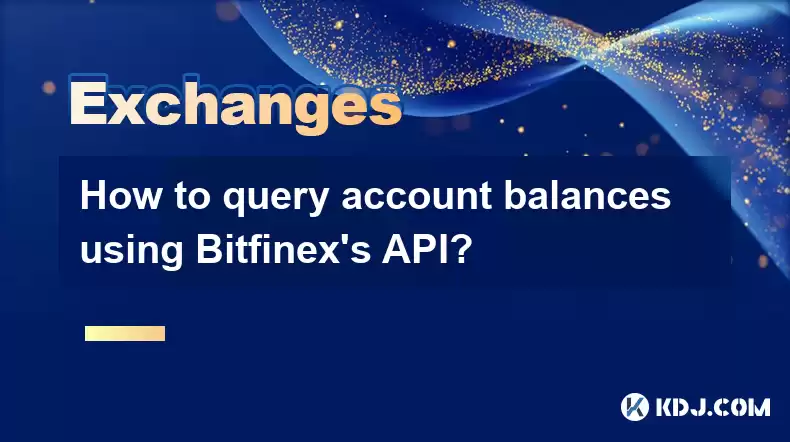-
 bitcoin
bitcoin $87959.907984 USD
1.34% -
 ethereum
ethereum $2920.497338 USD
3.04% -
 tether
tether $0.999775 USD
0.00% -
 xrp
xrp $2.237324 USD
8.12% -
 bnb
bnb $860.243768 USD
0.90% -
 solana
solana $138.089498 USD
5.43% -
 usd-coin
usd-coin $0.999807 USD
0.01% -
 tron
tron $0.272801 USD
-1.53% -
 dogecoin
dogecoin $0.150904 USD
2.96% -
 cardano
cardano $0.421635 USD
1.97% -
 hyperliquid
hyperliquid $32.152445 USD
2.23% -
 bitcoin-cash
bitcoin-cash $533.301069 USD
-1.94% -
 chainlink
chainlink $12.953417 USD
2.68% -
 unus-sed-leo
unus-sed-leo $9.535951 USD
0.73% -
 zcash
zcash $521.483386 USD
-2.87%
How to query account balances using Bitfinex's API?
Use Bitfinex's API to query account balances by authenticating with API keys, constructing a POST request to /v2/auth/r/wallets, and parsing the JSON response.
Apr 13, 2025 at 03:21 pm

Bitfinex, one of the leading cryptocurrency exchanges, provides a robust API that allows users to interact with their platform programmatically. One of the most common operations users perform is querying account balances. This article will guide you through the process of using Bitfinex's API to check your account balances, ensuring you can manage your funds efficiently and securely.
Understanding Bitfinex's API Authentication
Before you can query your account balances, you need to understand how to authenticate your API requests. Bitfinex uses a combination of API keys and a signature to ensure secure access to your account.
- Generate API Keys: Log into your Bitfinex account, navigate to the API section, and generate a new API key. Make sure to enable the necessary permissions for reading account balances.
- API Key and Secret: You will receive an API key and a secret key. Keep the secret key safe and never share it.
- Creating the Signature: For each API request, you need to create a signature using the secret key. The signature is generated by hashing the request payload with the secret key.
Setting Up Your Development Environment
To interact with Bitfinex's API, you need to set up your development environment. Here’s how to do it:
- Choose a Programming Language: Bitfinex's API can be used with various programming languages. Popular choices include Python, JavaScript, and Ruby.
- Install Required Libraries: For example, if you choose Python, you can use the
requestslibrary for making HTTP requests andhmacandhashlibfor creating the signature. - Set Up Your API Credentials: Store your API key and secret key securely in your development environment.
Constructing the API Request
To query your account balances, you need to construct an API request to the appropriate endpoint. Bitfinex provides the /v2/auth/r/wallets endpoint for this purpose.
- Endpoint:
https://api.bitfinex.com/v2/auth/r/wallets - HTTP Method:
POST - Payload: An empty array
[]is used for this request.
Creating the Signature
Creating the signature is a crucial step in authenticating your request. Here’s how to do it:
- Timestamp: Generate a timestamp in milliseconds. This timestamp must be included in the payload.
- Nonce: Use the timestamp as a nonce to ensure the request is unique.
- Payload: Construct the payload by concatenating the API path and the JSON-encoded payload.
- Signature: Use the HMAC-SHA384 algorithm to create the signature with your secret key and the payload.
Here is an example of how to create the signature in Python:
import timeimport jsonimport hmacimport hashlib
api_key = 'your_api_key'api_secret = 'your_api_secret'
Generate timestamp and nonce
timestamp = str(int(time.time() * 1000))nonce = timestamp
Construct the payload
payload = '/api/v2/auth/r/wallets' + json.dumps([])
Create the signature
signature = hmac.new(api_secret.encode(), payload.encode(), hashlib.sha384).hexdigest()
Sending the API Request
Once you have constructed the payload and created the signature, you can send the API request. Here’s how to do it in Python:
- Headers: Include the API key, signature, and nonce in the headers of your request.
- Send the Request: Use the
requestslibrary to send the POST request to the endpoint.
Here is an example of how to send the request in Python:
import requests
url = 'https://api.bitfinex.com/v2/auth/r/wallets'
headers = {
'bfx-nonce': nonce,
'bfx-apikey': api_key,
'bfx-signature': signature
}
response = requests.post(url, headers=headers, data=json.dumps([]))
if response.status_code == 200:
print(response.json())
else:
print('Error:', response.status_code, response.text)
Parsing the Response
After sending the request, you need to parse the response to extract your account balances. The response from Bitfinex will be in JSON format, containing an array of wallet objects.
- Wallet Objects: Each wallet object includes information such as the currency, balance, and type of wallet (e.g., exchange or margin).
- Extracting Balances: Iterate through the array to extract the balance for each currency.
Here is an example of how to parse the response in Python:
wallets = response.json()
for wallet in wallets:
currency = wallet[1]
balance = wallet[2]
print(f'Currency: {currency}, Balance: {balance}')
Handling Errors and Edge Cases
When querying account balances, it’s important to handle potential errors and edge cases:
- API Rate Limits: Bitfinex has rate limits on API requests. Ensure you do not exceed these limits to avoid being blocked.
- Authentication Errors: If your signature or nonce is incorrect, you will receive an authentication error. Double-check your authentication process.
- Network Issues: Be prepared to handle network-related issues, such as timeouts or connection errors.
Frequently Asked Questions
Q: Can I query account balances for multiple accounts using the same API key? A: No, each API key is tied to a single account. To query balances for multiple accounts, you need to generate separate API keys for each account.
Q: How often can I query my account balances using Bitfinex's API? A: Bitfinex imposes rate limits on API requests. You can typically make up to 90 requests per minute, but it’s best to check the current limits in the Bitfinex API documentation.
Q: What should I do if I encounter an authentication error when querying my account balances? A: Authentication errors usually occur due to incorrect signatures or nonce values. Ensure your timestamp is accurate and that you are using the correct secret key to generate the signature. If the issue persists, regenerate your API keys and try again.
Q: Can I use Bitfinex's API to query account balances in real-time? A: Bitfinex's API does not provide real-time streaming of account balances. You need to make periodic requests to the /v2/auth/r/wallets endpoint to get the latest balances.
Disclaimer:info@kdj.com
The information provided is not trading advice. kdj.com does not assume any responsibility for any investments made based on the information provided in this article. Cryptocurrencies are highly volatile and it is highly recommended that you invest with caution after thorough research!
If you believe that the content used on this website infringes your copyright, please contact us immediately (info@kdj.com) and we will delete it promptly.
- Ray Dalio's Portfolio Prescription: Why Bitcoin and Gold Are Essential in a Debt-Ridden World
- 2025-12-19 01:35:01
- Taiwan's Bitcoin Trove: Criminal Investigations Unearth a Surprising Global Ranking
- 2025-12-19 01:30:02
- Coinbase's Bold Leap: Stocks, Prediction Markets, and the Future of Trading
- 2025-12-19 01:35:01
- Kaito, Kickstarter, and the Post-TGE Crash: Navigating Crypto's Volatile Launch Landscape
- 2025-12-19 01:15:01
- Jito Foundation's Onshoring Signals a New Dawn for Solana and Crypto Regulation in the US
- 2025-12-19 01:25:01
- Cardano's Midnight Token (NIGHT) Shines Amidst Crypto Economy Evolution, Highlighting Privacy and Next-Gen Potential
- 2025-12-19 01:15:01
Related knowledge

What does it mean to "Hedge" a position on Bybit and how do I do it?
Dec 11,2025 at 07:00pm
Understanding Position Hedging on Bybit1. Hedging on Bybit refers to opening opposing positions in the same trading pair to reduce exposure to adverse...

How to secure my Bybit account against phishing and scams?
Dec 12,2025 at 11:39am
Enable Two-Factor Authentication (2FA)1. Log in to your Bybit account and navigate to the Security Settings section. 2. Select Google Authenticator or...

Why is the price mark on Bybit different from the last traded price?
Dec 17,2025 at 07:19am
Price Mark Mechanism on Bybit1. Bybit uses a mark price rather than the last traded price to calculate unrealized P&L and determine liquidation events...

How does Bybit's VIP program work and what are the benefits?
Dec 18,2025 at 05:00pm
Structure of Bybit VIP Program1. The Bybit VIP program categorizes users into tiers based on their 30-day average net asset value and trading volume a...

What is the "Reduce-Only" option on Bybit and how does it prevent accidental orders?
Dec 15,2025 at 10:40am
Understanding Reduce-Only Mode1. Reduce-Only is a risk control feature on Bybit that restricts order execution to positions that only decrease or clos...

How to convert small balances ("dust") to another coin on Bybit?
Dec 07,2025 at 08:59pm
Understanding Dust Conversion on Bybit1. Dust refers to tiny, non-withdrawable balances of cryptocurrencies left in a user’s spot wallet after partial...

What does it mean to "Hedge" a position on Bybit and how do I do it?
Dec 11,2025 at 07:00pm
Understanding Position Hedging on Bybit1. Hedging on Bybit refers to opening opposing positions in the same trading pair to reduce exposure to adverse...

How to secure my Bybit account against phishing and scams?
Dec 12,2025 at 11:39am
Enable Two-Factor Authentication (2FA)1. Log in to your Bybit account and navigate to the Security Settings section. 2. Select Google Authenticator or...

Why is the price mark on Bybit different from the last traded price?
Dec 17,2025 at 07:19am
Price Mark Mechanism on Bybit1. Bybit uses a mark price rather than the last traded price to calculate unrealized P&L and determine liquidation events...

How does Bybit's VIP program work and what are the benefits?
Dec 18,2025 at 05:00pm
Structure of Bybit VIP Program1. The Bybit VIP program categorizes users into tiers based on their 30-day average net asset value and trading volume a...

What is the "Reduce-Only" option on Bybit and how does it prevent accidental orders?
Dec 15,2025 at 10:40am
Understanding Reduce-Only Mode1. Reduce-Only is a risk control feature on Bybit that restricts order execution to positions that only decrease or clos...

How to convert small balances ("dust") to another coin on Bybit?
Dec 07,2025 at 08:59pm
Understanding Dust Conversion on Bybit1. Dust refers to tiny, non-withdrawable balances of cryptocurrencies left in a user’s spot wallet after partial...
See all articles









































































